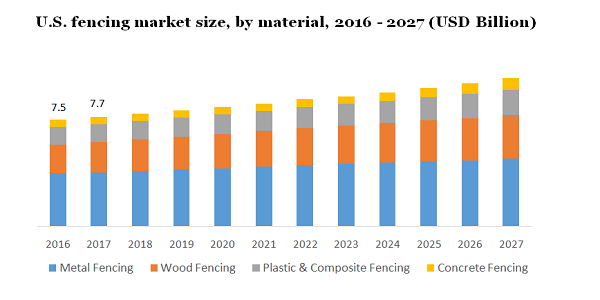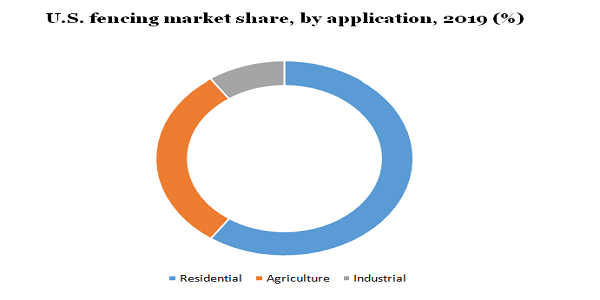- US: +1-408-610-2300
- Toll Free: +1-866-831-4085
- Become a Client
The U.S. fencing market size was accounted for USD 8.3 billion, in 2019. It is estimated to grow at a CAGR of 4.9% during the forecast period, 2020 to 2027. A growing number of construction activities in the U.S. is driving the market growth. Moreover, growing concerns regarding the security of houses and buildings and improving the appearance of properties are anticipated to propel the demand for fencing solutions and products.
The market is anticipated to attain significant growth owing to the developed and strong economy of the U.S. Moreover, the rising popularity of home décor products among large consumer groups is projected to further propel the product demand. The growing real estate industry and rising number of renovation projects are the factors projected to proliferate the product demand from 2020 to 2027. Furthermore, rising demand for fencing across industrial areas, colleges, and schools to improve the security aspects of premises is positively impacting the product demand. In addition, a growing number of projects for the development of gardens and parks is projected to further proliferate the market growth over the forecast period.

Raw material supply and price fluctuations are the key factors anticipated to affect the market growth. The rising adoption of ornamental fencing solutions is projected to further boost the regional market growth. Moreover, factors such as the availability of customized fencing solutions and fencing products coupled with rising disposable income levels are anticipated to propel the growth of the market over the forecast period. Moreover, the high performance of certain durable and eco-friendly raw materials is projected to further drive the demand for fencing products made using such materials.
However, volatile prices of raw materials and high costs of energy are some of the major factors projected to hinder market growth. Manufacturers of fencing products have to pay high duties on gas and electricity. Therefore, the majority of the manufacturers are increasing the cost of production which is helping them to overcome losses. In addition, high costs and low availability of certain metals required to produce colorful fencing products are projected to act as a hindrance to market growth.
Based on raw material, the U.S. fencing market is divided into wood, concrete, metal, and plastic & composite. In 2019, the metal segment held the largest market share across the U.S. market due to rising demand from government, agricultural, industrial, and residential sectors. Factors such as high security, durability, and low maintenance are projected to fuel the growth of the metal fencing segment. In addition, metal fencing products are available at different prices which help buyers to choose the appropriate products. Moreover, security aspects, aesthetics, and cost-effectiveness of metal fencing products are anticipated to drive the growth of the segment over the forecast period.
The segment of concrete fencing is projected to attain the fastest growth from 2020 to 2027 due to the high strength of concrete material and ease of maintenance and installation of the product. Moreover, the availability of a variety of concrete fencing with different designs and options of customization are projected to further propel the segment’s growth. In addition, rising demand for the stackable types of concrete fencing across the non-residential sector is projected to proliferate the growth of the segment from 2020 to 2027.
On the basis of distribution channels, the market is categorized into retail and online distribution channels. Benefits offered by online channels such as low-cost initial investment, high customer satisfaction, and requirement of less capital are projected to influence sellers to offer their products through online retail platforms. Moreover, rising preference for online channels among a large number of consumers owing to doorstep delivery, availability of a variety of products, offers, deals, and the option of customization is projected to further fuel the segment’s growth
In 2019, the retail segment held the largest market share, in terms of revenue. The majority of the leading manufacturer of fencing products in the U.S. offer their products through retail channels owing to high product visibility and brand awareness offered by offline channels. This has been one of the major forces driving the sales of fencing products through the retail distribution channel.
The market is categorized into contractors and Do-It-Yourself, on the basis of the installation. Contractors use high-quality raw materials to install fences around various residential and non-residential buildings which makes the fencing exceptionally durable. Moreover, the installation of fences by professionals saves the efforts and time of the consumers and it improves the aesthetics of buildings which is boosting the popularity of contract-based installation across the U.S. market.
The DIY fencing packages fulfill specific consumer requirements. However, lack of experience in installing fences leads to low-quality installation which deteriorates the aesthetic appeal of the property.
On the basis of end-users, the United States fencing market is categorized into transport, petroleum and chemicals, government, military and defense, energy and power, mining, and other segments. The segment of military and defense held the largest market share in 2019 due to high product penetration across the sector. Moreover, the wide application of fencing products for improving the security aspects of defense infrastructure and military buildings is projected to propel the segment’s growth. In addition, constant exposure of military areas and buildings to bombings and potential attacks is projected to create promising growth opportunities for the manufacturers of fencing products over the forecast period.
The segment of power and energy is projected to attain notable growth from 2020 to 2027 owing to the high requirement of security equipment such as fencing products, barricades, and CCTVs around the premises of power and energy stations. Moreover, rising incidences of terrorist attacks have influenced governments to use electric fencing products to ensure tight security at energy stations and power generation plants which thereby anticipated to proliferate the segment’s growth in the forthcoming years.
On the basis of application, the US Fencing Market is divided into industrial, residential, and agricultural sectors. In 2019, the residential application segment held the largest market share with revenue of USD 5.3 billion and is projected to maintain its dominance from 2020 to 2027. This is attributed to the rising number of construction activities, growing need for security and privacy, and rising real estate sector in the U.S. Moreover, rising consumer expenditure on renovation projects and increasing spending power of consumers are projected to drive the demand for fencing products and solutions across the residential sector.

Metal and PVC fencing are widely used across the residential segment owing to high durability, flexibility, and low maintenance. Moreover, PVC fencing improves the aesthetic appeal of houses which is further projected to proliferate its demand over the forecast period. The agricultural application segment is projected to attain significant growth from 2020 to 2027 owing to the growing need for protecting the agricultural fields from wild animals and trespassers.
Leading states propelling the demand for fencing products and solutions are Arizona, Alabama, California, Connecticut, Colorado, Florida, Idaho, Georgia, Illinois, Iowa, Indiana, Louisiana, Massachusetts, Maryland, Michigan, Mississippi, Minnesota, Missouri, New Jersey, New Hampshire, New Mexico, North Carolina, New York, Oklahoma, Ohio, Oregon, South Carolina, Pennsylvania, Texas, Tennessee, Utah, Washington, Wisconsin, and Virginia. A growing number of construction projects and growing infrastructural development in California are some of the major factors anticipated to propel the growth of the overall market. Moreover, the rising demand for fencing products in California due to the rising number of transportation activities is anticipated to further fuel the market growth.
In addition, the growing real estate industry in Virginia is anticipated to create potential growth opportunities for manufacturers of fencing. Moreover, the rising number of construction projects and increasing demand for fencing from agricultural sectors are the factors anticipated to drive the regional market. Furthermore, the growing adoption of ornamental fences across the residential sector in the U.S. is projected to contribute to the market growth over the forecast period.
Leading players operating in this industry include Gregory Industries, Inc.; Allied Tube & Conduit; Long Fence Company, Inc.; Associated Materials LLC; Bekaert; CertainTeed Corporation; Ply Gem Holdings; Poly Vinyl Creations Inc.; and Jerith Manufacturing Company Inc. These players are focusing on developing new and improved fencing products to maintain their market position. There has been high dominance by leading industry players and the market is projected to witness a growing number of new entrants that target niche segments in the market. Key players are focusing on mergers and acquisitions with local or regional players to gain an edge over other competitors.
With the presence of a large number of leading as well as small/local players, the market is highly competitive in nature. The rising number of local and regional players offering products at relatively cheap prices is anticipated to be a threat for key industry players.
|
Attribute |
Details |
|
The base year for estimation |
2019 |
|
Actual estimates/Historical data |
2016 - 2018 |
|
Forecast period |
2020 - 2027 |
|
Market representation |
Revenue in USD Million and CAGR from 2020 to 2027 |
|
Regional scope |
U.S. (Alabama, Arizona, California, Colorado, Connecticut, Florida, Georgia, Idaho, Illinois, Indiana, Iowa, Louisiana, Maryland, Massachusetts, Michigan, Minnesota, Mississippi, Missouri, New Hampshire, New Jersey, New Mexico, New York, North Carolina, Ohio, Oklahoma, Oregon, Pennsylvania, South Carolina, Tennessee, Texas, Utah, Virginia, Washington, Wisconsin) |
|
Report coverage |
Revenue forecast, company ranking, competitive landscape, growth factors, and trends |
|
15% free customization scope (equivalent to 5 analysts working days) |
If you need specific information that is not currently within the scope of the report, we will provide it to you as a part of the customization |
This report forecasts revenue and volume growth at global, regional, and country levels and provides an analysis of the latest industry trends in each of the sub-segments from 2016 to 2027. For the purpose of this study, Million Insights has segmented the U.S. fencing market report on the basis of material, distribution channel, installation, application, end-use, and region:
• Material Outlook (Revenue, USD Million, 2016 - 2027)
• Metal
• Aluminum
• Steel
• Others
• Wood
• Plastic & Composite
• Concrete
• Distribution Channel Outlook (Revenue, USD Million, 2016 - 2027)
• Online
• Retail
• Installation Outlook (Revenue, USD Million, 2016 - 2027)
• Do-It-Yourself
• Contractor
• Application Outlook (Revenue, USD Million, 2016 - 2027)
• Residential
• Agricultural
• Industrial
• End-use Outlook (Revenue, USD Million, 2016 - 2027)
• Government
• Petroleum & Chemicals
• Military &Defense
• Mining
• Energy & Power
• Transport
• Others
• Regional Outlook (Revenue, USD Million, 2016 - 2027)
• Alabama
• Arizona
• California
• Colorado
• Connecticut
• Florida
• Georgia
• Idaho
• Illinois
• Indiana
• Iowa
• Louisiana
• Maryland
• Massachusetts
• Michigan
• Minnesota
• Mississippi
• Missouri
• New Hampshire
• New Jersey
• New Mexico
• New York
• North Carolina
• Ohio
• Oklahoma
• Oregon
• Pennsylvania
• South Carolina
• Tennessee
• Texas
• Utah
• Virginia
• Washington
• Wisconsin
• Others


Research Support Specialist, USA